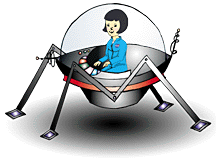|
|
The Sun |
|
|
The Sun |
![]()
 |
Wow!Many ancient peoples worshiped the Sun as a god. They thought a solar eclipse meant the god was angry with them. They believed the Sun god's anger could only be calmed with prayer and sacrifice. |
| The diameter of our closest star, the Sun, is 1,392,000 kilometers. The Sun is thought to be 4.6 billion years old. The Sun is a medium size star known as a yellow dwarf. It is a star in the Milky Way galaxy and the temperature in its core is estimated to be over 15,000,000 degrees Celsius. In the Sun's core, hydrogen is being fused to form helium by a nuclear fusion process. The energy created by this process radiates up to the visible boundary of the Sun and then off into space. It radiates into space in the form of heat and light. Because the Sun is so massive, it exerts a powerful gravitational pull on everything in our solar system. It is because of the Sun's gravitational pull that Earth orbits the Sun in the manner that it does. |
|
|
The Sun has several layers: the core, the radiation zone, the convection zone, and the photosphere (which is the surface of the Sun). In addition, there are two layers of gas above the photosphere called the chromosphere and the corona. Events which occur on the Sun include sunspots, solar flares, solar wind, and solar prominences. Sunspots are magnetic storms on the photosphere which appear as dark areas. Sunspots regularly appear and disappear in eleven year cycles. Solar flares are spectacular discharges of magnetic energy from the corona. These discharges send streams of protons and electrons outward into space. Solar flares can interrupt the communications network here on Earth. Solar winds are the result of gas expansion in the corona. This expansion leads to ion formation. These ions are hurled outward from the corona at over 500 kilometers per second. Solar prominences are storms of gas which erupt from the surface in the form of columns which either shoot outward into space or twist and loop back to the Sun's surface. |
| Show me a movie about the SunThis movie is large, but worth the wait!Movie courtesy of NASA |
![]() Sing me part of a song about the Sun!
Sing me part of a song about the Sun!
(Words)
A QuestionOur Sun is classified as what type of star? |
| The Facts |
Did You Know? |
The Answer |
![]()
| Show me the Level 1 version of this page. |
The StarChild site is a service of the High Energy Astrophysics Science Archive Research Center (HEASARC), within the Astrophysics Science Division (ASD) at NASA/ GSFC.
StarChild Authors: The StarChild Team
StarChild Graphics & Music: Acknowledgments
StarChild Project Leader: Dr. Laura A.
Whitlock
Curator:
Responsible NASA Official: